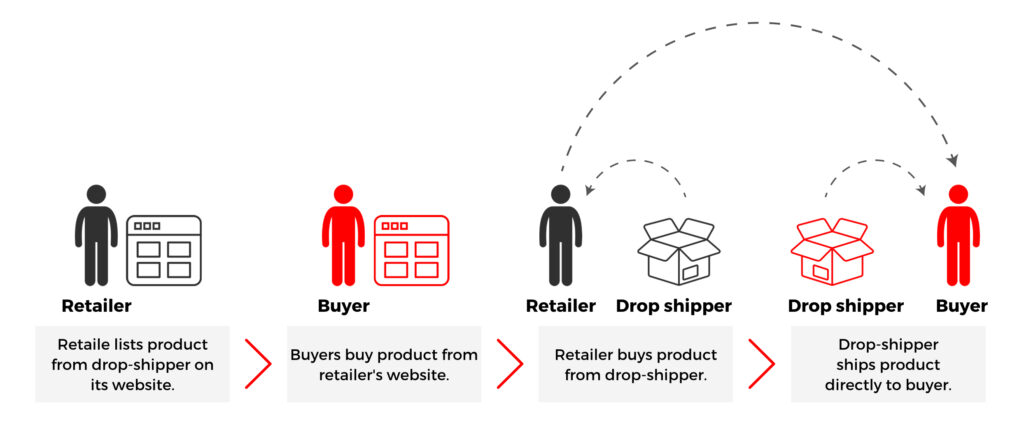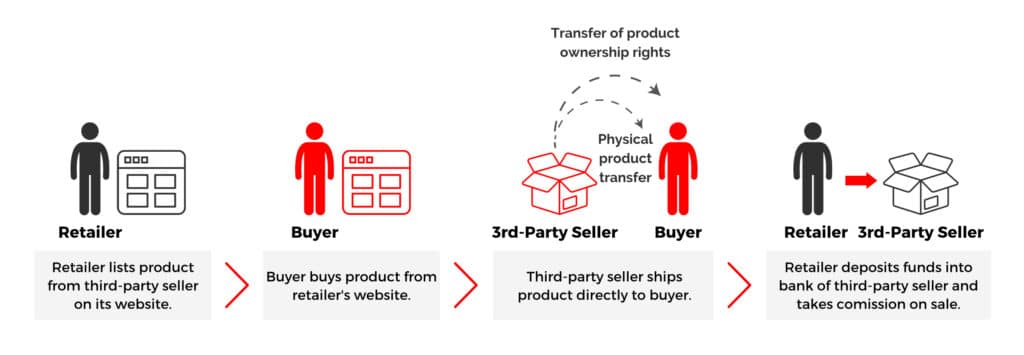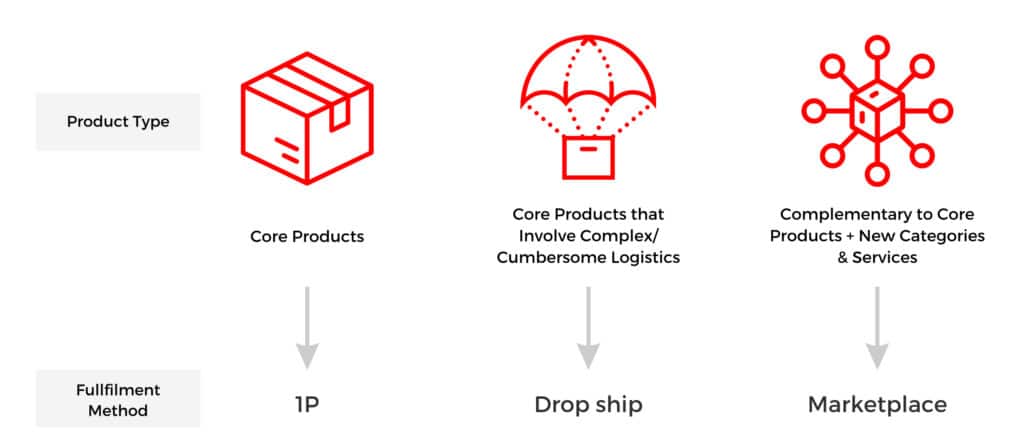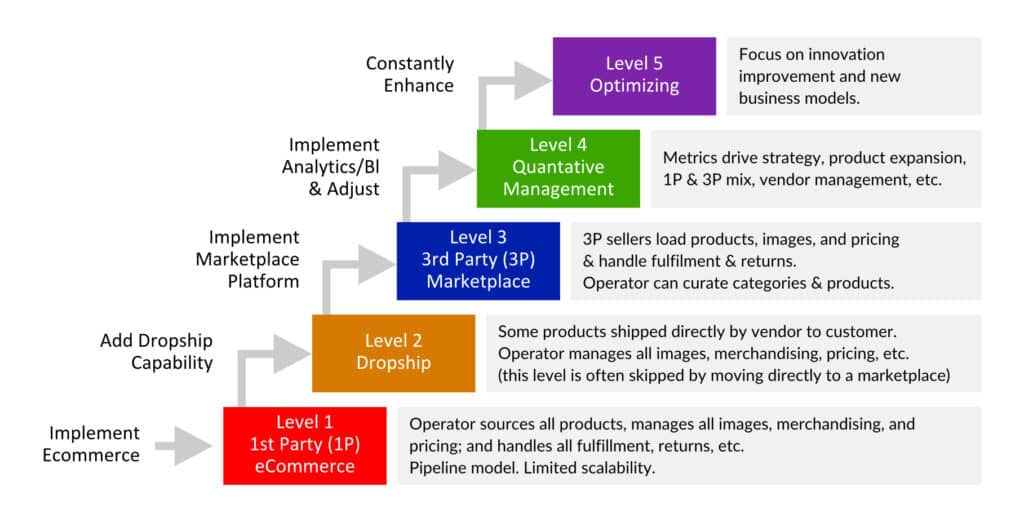 A Modern Dropship Program Is The Foundation Of A Functional Marketplace Solution
A Modern Dropship Program Is The Foundation Of A Functional Marketplace Solution
By Jager Robinson | December 14, 2023
Expanded assortment. Endless aisle. These are two terms for the same concept—a finely tuned eCommerce solution. Creating a seamless experience for consumers, one that doesn’t take them off your website but rather gives them enough curated options to purchase their entire order directly through one site relies on a fully functioning dropship program.
Dropshipping is the cornerstone of eCommerce and is the pillar of any good marketplace program. Amazon, for example, would not be the powerhouse it is today without carefully creating an environment that allows for rapid supplier onboarding, fast-moving product data, and accelerated shipping sometimes directly from the supplier. Once Amazon’s dropshipping program was in place, they easily transitioned to a marketplace model focused heavily on providing every possible item consumers could need at the touch of a button.
Understanding Dropshipping
Launching your own dropshipping program has become much easier over the years. Even though supply chains, raw material availability, and shipping costs have all been challenged, advanced AI and API technologies have allowed enterprise tech partners like Logicbroker to stay ahead of the curve.
Before you get started building your program, however, it’s vitally important to understand the basics, benefits, and considerations of a dropshipping program, so you can accurately decide if this unique fulfillment model is the right fit for your organization.

Basics
Dropshipping is a way for retailers to fulfill orders without having to hold their own inventory. Instead, when a retailer sells a product, they buy and have it shipped to the customer from a third-party supplier. Organizations like Walgreens utilize dropshipping programs to expand their online assortment without needing to carry every SKU in their distribution centers. Traditionally, the retailer’s branding appears on the packing slip and packaging, so the end customer may never even realize the product isn’t coming directly from the retailer.
Benefits
Dropshipping carries some heavy benefits. It is the first step into a larger eCommerce hybrid fulfillment solution. However, these are three benefits of a pure dropshipping solution that you will see within the first few months of your go-live date.
1) Incrementally Expand
Dropshipping is the logical progression from owned inventory. As your organization expands and housing thousands of SKUs in warehouses becomes cost-prohibitive due to capital investment in inventory, and rising labor, warehouse, and tech investment costs, having a controlled eCommerce ecosystem with your top-performing suppliers fulfilling directly to consumers is a no-brainer.
Whether your warehouse and/or labor is at capacity, or you just want to test and learn with new products, retailers, and brands, retailers looking at assortment expansion often think of dropship due to a modern program’s speed-to-market and unmatched flexibility.
2) Embrace Supply Chain Resilience
Inventory availability is anything but secure globally. Microchip availability continues to impact almost every vertical, foam shortages are changing how furniture retailers source their most sought-after goods, and challenges in demand forecasting continue to puzzle even the most experienced specialists. And as more retailers run out of stock, consumers are left scrambling to utilize any and all websites to find what they were looking for.
Luckily, dropshipping helps resolve some of these major pain points. Through a finely curated selection of top-performing suppliers, coupled with your owned inventory selection, well-managed dropshipping programs allow retailers and brands to quickly pivot in the wake of supply chain challenges. If one of your suppliers runs out of a top-performing product, your dropship program can easily fill the gap with a second and third supplier option, giving your consumers more choices without leaving your site.
Internally, this resilience extends through your owned inventory channels. If retailers sell out of a product you normally have well stocked in local distribution centers, a well-honed dropshipping program can easily let you automatically switch to supplier fulfillment making the transition as seamless and effortless for customers as they demand.
3) Maximize Control Without Changing Your Business
While expanding from owned inventory into dropshipping may feel overwhelming and disparate from product movement, dropship models actually give you a remarkable amount of control and fundamentally will not change your core business. Both dropshipping and owned inventory models operate the same financially. Both solutions are “buy low, sell high” models utilizing either your own or your supplier networks inventory.
In a well-crafted dropship model, retailers maintain responsibility for all customer-facing product windows. Customers will still rely solely on the retailer for product, price, promotion, and placement giving retailers looking to embrace new eCommerce solutions the control they need to manage their brand identity, ensure a well-rounded customer experience, and continue to provide the latest target products for their customers without changing their internal business models.
Considerations
Like every eCommerce solution, there are some considerations before jumping in, but we are going to focus on one—it’s just plain difficult to set up correctly. Most retailers assume a dropshipping program boils down to two key things: calling a supplier and then asking them to ship products directly to consumers after an order is made.
This ignores the thousands of steps that allow for more automated order processes, quicker shipping times to appease consumers, and ultimately greater control over your eCommerce program. The reality is, dropshipping is very difficult without the right tech partner.
Implementing a fully functional dropship program with the wrong tech partner can be tedious, at best. There have been massive improvements with modern tech speeding up the supplier onboarding process with solutions like Logicbroker being able to onboard suppliers in under an hour. However, if the supplier requires an EDI connection, they may be held up by internal tech teams or third-party EDI providers, rather than your tech partner.
A tech partner’s portal or broader set of integration options can speed this up and ease the burden of implementing both a dropship program and a visibility program as you continue to grow, all while your internal or third-party EDI providers catch up.
Defining The Marketplace Model
When it comes to eCommerce, the terms “marketplace” and “dropship” are often used interchangeably. However, it’s crucial to grasp the fundamental distinctions between these two models.
A third-party marketplace serves as a digital platform that connects buyers with sellers, facilitating sales transactions. Businesses that operate using the marketplace model allow third-party sellers to list their products or services on the marketplace website. In this model, sellers directly engage with customers and assume the role of the merchant.
On the other hand, the dropshipping model involves the merchant or retailer acting as both the seller and price-setter. Contrastingly, in the marketplace model, the supplier takes on the responsibilities of both seller and price-setter. This distinction is the key factor that sets dropshipping apart from the marketplace model.

A True Hybrid Approach
With definitions behind us, it’s important to understand that a one-size-fits-all approach to dropship or marketplace solutions is no longer effective. Simple eCommerce solutions will leave you trailing behind your competitors. The days of choosing an eCommerce model to comply with tech providers’ limitations are gone.
You need a partner that is flexible, able to pivot, can scale with your organization, and provides the visibility you need to grow your customer base. Businesses need to create a personalized and seamless online shopping experience that meets their customers’ unique needs and preferences through proven hybrid models that embrace different fulfillment models.
A complete eCommerce solution that encompasses dropship and marketplace offerings will bring a wide range of benefits to businesses of all sizes and industries. The reality is that all retailers (as well as most brands and suppliers) are competing in some way with titans like Amazon, Walmart, and Target.
By integrating your eCommerce capabilities into a single platform, businesses can optimize their operations, increase profitability, and deliver exceptional customer experiences.

Your dropship program with Logicbroker will enable your business to expand its product offerings without having to hold inventory or manage logistics. At the same time, your marketplace solution will enable you to partner with third-party sellers and expand your reach and customer base.
By combining dropship and marketplace into a single eCommerce solution, businesses can optimize their operations and deliver exceptional customer experiences—which is what eCommerce is all about.
The McFadyen Marketplace Maturity Model Guide
To help retailers and brands better capitalize on this dropship and marketplace unification, McFadyen Digital created The Marketplace Maturity Model. This model is a strategic blueprint for businesses navigating the complex terrain of eCommerce, from first-party sales to a fully operational third-party marketplace. This model outlines a clear pathway that emphasizes scalability, profitability, and automation at each stage. It is designed to provide businesses with a comprehensive understanding of how to transition smoothly and effectively, highlighting key areas such as vendor management, product assortment, and logistics.
The Dropship phase of the Marketplace Maturity Model plays a pivotal role as it forms the bridge between first-party eCommerce and a fully-fledged marketplace. This stage, which can be extremely robust and profitable in its own right, allows businesses to broaden their product offerings without the burden of inventory management by leveraging third-party suppliers. It offers a unique opportunity to enhance customer satisfaction through diversity in product range. However, this stage also presents its unique challenges, including vendor onboarding, product curation, and logistics management. Understanding these elements enables businesses to successfully implement a dropship program and sets the foundation for the next stage in the Marketplace Maturity Model.

As businesses traverse through the stages of the model, it is necessary to maintain a dedicated focus on continuous optimization and enhancement using data to drive decisions. This focus on metrics-driven management, automation, and platform enhancements can help businesses stay competitive and maximize the value of their marketplace.
By leveraging data insights and implementing incremental improvements, businesses are not only able to adapt to the ever-evolving digital commerce landscape but also able to position themselves at the forefront by creating a multi-sided multi-vendor commerce ecosystem.
A True Partnership
Earlier this year, McFadyen Digital and Logicbroker announced a joint strategic partnership to deliver best-in-class eCommerce solutions & services to enterprise retailers and brands.
The partnership has provided Logicbroker and McFadyen customers with a range of services including dropship fulfillment and supply chain experience management. Over the last few months, both teams have worked to combine McFadyen’s strategic and technical implementation expertise with Logicbroker’s revolutionary API-driven eCommerce platform and scalable solutions. We’ve helped several enterprise retailers revolutionize their online buying experience in a meaningful way.
For more information about how the two organizations have come together, please visit both of our websites. To discover more about how a dropshipping program can tie perfectly into a one-solution eCommerce approach, read Logicbroker’s Complete Fulfillment Solutions Guide.
About Logicbroker
Logicbroker is a premier multi-vendor commerce platform that seamlessly connects trading partners regardless of integration types. Our modern solutions empower retailers and brands to take control of their customer experience by harnessing and analyzing vital first-party data, reducing inventory risk, and curating their expanded assortment. By improving the visibility into our client’s commerce programs, Logicbroker can better position retailers and brands for transformative growth.
As business needs and demand shift, Logicbroker provides the ability to quickly switch suppliers and product fulfillment between 3P to 1P and responsibly find new sources of inventory that uphold your brand integrity and meet your delivery promise. We work with mid-market and Enterprise manufacturers and retailers across a number of verticals including Health & Wellness, Home Improvement, Consumer Electronics, Toys & Babies, and Consumer Packaged Goods and service brands such as Samsung, Victoria’s Secret, The Vitamin Shoppe, Walgreens, Ace Hardware, and BBQGuys.
About McFadyen Digital
McFadyen Digital is the leading global agency for ecommerce marketplace strategy, implementation, and performance management. Supporting the complete marketplace operator journey, we take a collaborative approach to composable digital marketplace technology, strategy, architecture, and integrations, working with leading enterprises to ensure their customers are delighted by scalable and profitable shopping experiences.
As a truly global firm with active clients spanning five continents, we offer the competitive advantages of rapid deployment, world-class quality, and reduced costs. Global collaboration is ingrained into our culture, so we know how to make this flexible delivery model result in value for our clients and partners.
For more information visit mcfadyen.com.
Modern dropship & marketplace solutions have never been so easy.
Are you ready to drive growth and gain unparalleled speed to market with a modern, scalable dropship or marketplace program? Fill out the form below to get in touch with our team: